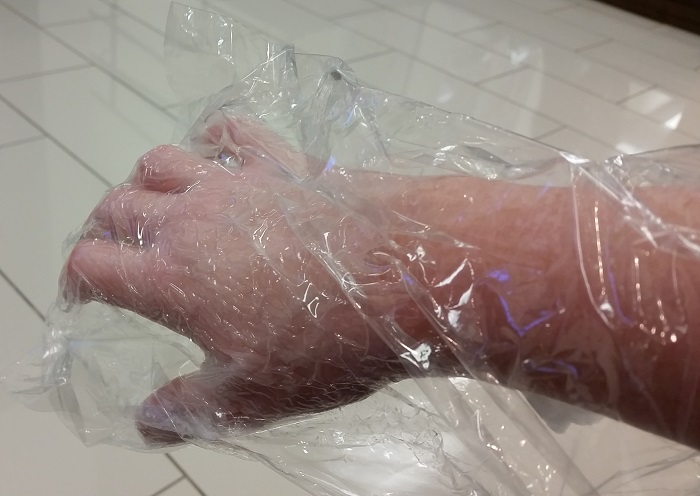When this past summer turned to autumn, the leaves started to fall, and the weather got cooler… Wait a minute – that sounds like the opening line of a bad novel. Let me try that again!
At the end of the summer (that’s better!), my physiotherapist asked me an odd question. Had any of my physicians had suggested hot paraffin treatments for my right hand? He thought the warm wax might help with some of the symptoms of my rare neuro-inflammatory disease.
My right hand and lower arm are affected by Complex Regional Pain Syndrome (CRPS), also called Reflex Sympathetic Dystrophy (RSD). Read Code breaking for information on CRPS/RSD. This disease usually affects the limbs and extremities (the lower arm and hand, or the lower leg and foot), and causes a multitude of signs and symptoms:
- Signs = What medical professionals can feel, see, measure, test (including blood tests & scans)
- Symptoms = What a patient experiences (in this case, me)
Different patients with this disease may have different signs and symptoms, to varying levels. But one symptom experienced by almost everyone with CRPS is a bad reaction to cold temperatures, in the affected area of the body. It makes my hand and arm:
extremely sensitive to changes in temperature because the damaged nerves are no longer able to properly control blood flow, feeling (sensation), and temperature to the affected area”(1).
This sensitivity to cold may also be because of “an abnormal (side different) reflex pattern of sympathetic vasoconstrictor neurons due to thermoregulatory stimuli generated in the central nervous system”(2). That means, more or less, that the body’s temperature control isn’t working properly in the area affected by CRPS.
So this sensitivity to cold could be caused by problems with the blood vessels, or by a malfunction in body’s temperature control system – in the specific area with CRPS. There’s a lot about CRPS that’s unknown, so this is the kind of ‘maybe it’s this, maybe it’s that’ outlook that I’m still getting used to!
I live in Montreal, where we have very cold winters which seem to last half the year, so this is really a problem for me! And I love winter sports; cross-country skiing, skating, and snowshoeing (up and down mountains, in the Adirondack Mountains of northern New York State).
Another common symptom of CRPS is joint pain, which is – of course! – also worse in cold weather. The type of treatment that my physiotherapist does for me is called manipulation and mobilization (M&M), of my finger and wrist joints. Feel free to read M&M physiotherapy if you’d like a more detailed description.
The goal of M&M is to try to ‘break’ the adhesions that have formed in my wrist and in every joint of each of my fingers. It’s as though my physiotherapist is trying to force apart scar tissue inside each joint, to break it up. And yes, it hurts. It hurts even more when the weather’s cold.
My physiotherapist’s idea was to get a small paraffin wax heating machine, at the clinic where I have the M&M treatment. A machine just big enough that I could dip my entire hand into it.

Research has shown that, for hand rehabilitation practices like physical therapy, hot paraffin treatments:
with joint mobilization techniques are more effective than mobilization techniques without paraffin wax bath”(3)
Another research project showed that hot paraffin treatments were beneficial for people suffering with joint pain caused by rheumatoid arthritis:
“combined with exercises can be recommended for beneficial short term effects for arthritic hands”(4)
So he wondered whether hot paraffin treatments could help with the joint pain caused by CRPS in my hand and wrist. I checked with one of my specialists, who agreed with me that the risk/benefit analysis looked good; that there was very little risk of harm, with a potential benefit to me.
So my physiotherapy clinic ordered a small paraffin wax heating machine, and I’ve used it a few times now. After each M&M session, when my finger and wrist joints are really painful, it’s soothing to submerge my entire hand and wrist into the hot paraffin.
I dip the hand in and out of the hot wax several times, and then my physiotherapist wraps the wax-coated hand and arm in plastic. He wraps a towel around the plastic wrap, to keep my arm warm.
We leave this plastic-wrapped wax on my hand for 15 minutes, sometimes longer. It really does make a difference, if only for a half hour or so. And it’s like a bit of a reward, after my painful M&M sessions.
Sometimes, with rare diseases as with life in general, the small things really do make a big difference ‘-)
References:
(1) VeriMed Healthcare Network. Complex regional pain syndrome. MedlinePlus, the National Library of Medicine, the National Institutes of Health, or the U.S. Department of Health and Human Services. Updated 19 Sep 2016. Web:
https://medlineplus.gov/ency/article/007184.htm
(2) Baron R, Maier C. Reflex sympathetic dystrophy: skin blood flow, sympathetic vasoconstrictor reflexes and pain before and after surgical sympathectomy. Pain. 1996 Oct;67(2-3):317-26. Web: https://www.ncbi.nlm.nih.gov/pubmed/8951925
(3) Sibtain, Fozia, Asghar Khan, and Syed Shakil-ur-Rehman. Efficacy of Paraffin Wax Bath with and without Joint Mobilization Techniques in Rehabilitation of Post-Traumatic Stiff Hand. Pakistan Journal of Medical Sciences 29.2 (2013): 647;650. Web: https://www.ncbi.nlm.nih.gov/pmc/articles/PMC3809244/
(4) Robinson V, Brosseau L, Casimiro L, Judd M, Shea B, Wells G, Tugwell P. Thermotherapy for treating rheumatoid arthritis. Cochrane Database Syst Rev. 2002;(2):CD002826. Web: https://www.ncbi.nlm.nih.gov/pubmed/12076454
